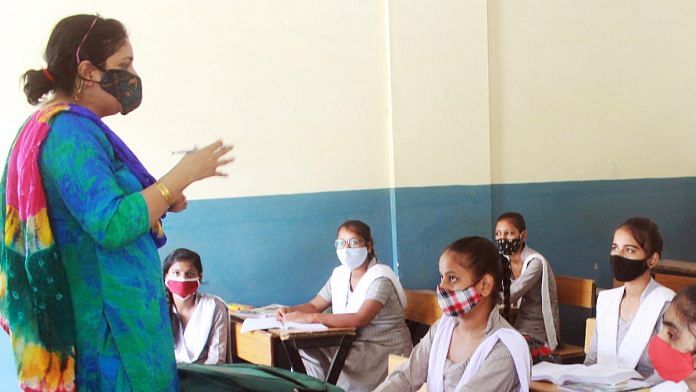New Delhi: At a time when education has become a flashpoint between Delhi Chief Minister Arvind Kejriwal and Lieutenant Governor (L-G) V K Saxena, a look at a study published four months back offers a telling picture of the state of schools in the national capital — 89 per cent of those run by the AAP government are short of classrooms.
The chief minister has accused the L-G of malicious intent after the latter scrapped his government’s proposal to have Delhi teachers sent on an official tour to Finland.
“My only objective is to provide education to all children, from rich to poor,” Kejriwal had said in the assembly Monday. “There should be no partiality. To provide good education to every child in Delhi, we want to send 30 of our teachers to Finland but the L-G is sitting on the file and is trying to stop these teachers.”
However, if a working paper published last September is any indication, what Delhi needs more is classrooms. The paper, titled ‘Estimating the Excess Demand for Government Schools in Delhi: How much capacity creation is necessary?’, was authored by Priyanta Ghosh and Sukanya Bose of the Delhi-based National Institute of Public Finance and Policy (NIPFP).
The NIPFP is a policy research centre established in 1976 by the Ministry of Finance.
The paper found that schools run by the Municipal Corporation of Delhi (MCD) fared a little better — these have a 70 per cent classroom deficit.
The research assumes significance given the pride that the AAP government takes in its education reforms. In February 2022, when faced with allegations of not opening more schools, Kejriwal had said that his government built 20,000 classrooms in seven years.
It was these education reforms that the AAP had promised to replicate in Punjab during the assembly elections last year, which it won by a landslide.
Also Read: Why Indian parents are shifting kids to govt schools, but spending more on private tutors
Excess demand for schools
Classroom deficit maps the demand for classrooms in comparison to actual availability — that is, it measures the actual number of classrooms in proportion to the number of students.
For this, authors used data from several sources — the Unified District Information System for Education Plus (till 2018-19), which is a database of schools, teachers, and students maintained by the Ministry of Education, as well as the National Sample Survey’s 2017 round and Census 2011.
The authors assume a 2 per cent population growth for Delhi based on the population growth from 2001 to 2011.
The survey takes into account students studying in Low-Fee Private Schools (LFPS) — that is, private schools that students opted for either because a government school was too far away from their homes or because they were suffering from what the paper calls “ills of congested government schools in urban fringes”.
It also takes into account children who are out of school (both dropouts and those who have never been to school) and factors in potential enrollments owing to a rise in population.
For government schools, the authors use a student-classroom ratio — that is, the number of students per classroom. Based on these, the authors calculated the number of classrooms required.
The whole exercise maps both schools operated by the Municipal Corporation of Delhi and the Delhi government’s Directorate of Education (DoE).
Acute shortage
The study found that of the DoE schools, 40 per cent were facing acute classroom deficit as compared to only 12 per cent of the MCD-run primary schools.
The study also reported a significant teachers’ crunch.
“Going by the grade-wise Pupil Teacher Ratio norm, 94 per cent of MCD schools experience teacher deficits, whereas the similar figure for DoE schools is 65 per cent. This calculation doesn’t separate guest teachers from regular teachers. Thus, even after including guest teachers, teacher deficits are widespread. The majority of students studying in government schools in Delhi are in schools with teacher shortages,” the study says.
The authors recommend that the Delhi government build around 632 composite schools (all classes included) and 275 primary government schools.
It estimates that building these additional schools would cost between “Rs 5,032 crore to Rs 6,937 crore or 0.61 per cent to 0.83 per cent of GSDP of Delhi, depending on the scenario”.
“Thus, the necessary expansion requires very substantial additional investments in new capacity creation in the public school system”, the study says.
“A natural corollary of the absence of sufficient investments in the public school system is not only privatisation and commercialisation, but privatisation at the bottom and the growth of LFPSs,” the paper says.
“Since the state cannot provide, private schools are allowed, no matter if they operate without recognition and are of substandard quality.”
Lack of public investments in schools of adequate quality and in sufficient numbers lies at the heart of the privatisation drives, the paper says. “Then, the only way to reverse the unequal system is a proper expansion of the government school system, ensuring access and participation. The pandemic adds an urgency to this imperative of expansion of the GS system,” the authors concluded.
(Edited by Uttara Ramaswamy)
Also Read: From counting 1-10 to telling time, what Modi govt says your kids should learn from age 5 to 9



